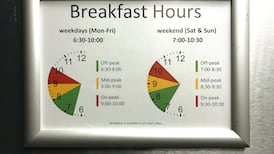‘It’s a year on since the flag came down and people might have fond memories of how good it was, people taking to the streets, standing together.’
Leading loyalist “flags” protester Jamie Bryson was responding on Tuesday to suggestions that he had pitched his hopes too high in predicting a turnout of “up to 2,500” marchers at a “civil rights parade and rally” in Bangor on the last Saturday before Christmas.
Many might attend, then, not – or at least not primarily – out of belief that the demonstration could force a change in policy on flags but because a show of strength on the streets would provide a positive feeling.
The Bangor event is intended as a follow-up to Saturday’s parade in Belfast city centre, which organisers predict will attract 10,000 supporters on what is apparently the biggest shopping day of the year.
Whether the anticipated feelgood factor, or any other consideration, will attract these numbers to Belfast or Bangor remains to be seen. What’s certain is that the pleas of traders and of every mainstream northern political party for the events to be called off in the interests of commerce are very unlikely to be listened to.
Defiance
Standing in defiance of established political leaderships, including and even especially the leadership of unionism, is an integral part of the protests' appeal. And hitting the profits of traders won't cost Jamie a thought.
Walking through Belfast a few months ago towards the Europa Bus Station, I chanced into a crowd of perhaps 500, loosely assembled at the front of the City Hall, many either carrying or draped in union flags. I paused for what could at a stretch be regarded as banter, and might have stayed longer if it hadn’t been for the need to catch the Derry bus. There was no sense of threat: this was in broad daylight and with as many PSNI officers as protesters in the vicinity. (Had I encountered a gathering of the same sort at midnight on the Newtownards Road my reaction might have been not to stop for a chat but to run like the wind.)
The striking point the half dozen or so who clustered around wanted to make was – in subbed-down form – that nationalists had “won” because “You [sic] all stuck together”, whereas, “nobody stands up for us.” A woman about 50 added (and I have this one verbatim): “We haven’t even got anybody to vote for.”
If this is what she genuinely believed, she will indeed have felt better for being with like-minded souls on the street.
The same feeling of alienation can also, of course, be channelled into vicious and visceral hatred of Catholics. But that doesn't mean it's not real and based on
real material circumstance.
The relevant difference between the unionist and nationalist communities does not have to do with one side sticking together (which it didn’t) and the other not. To the extent that this happened, it reflected already existing and sharpening differences in the class structure of the different communities.
It is commonly observed that the historical function of unionist rituals and institutions – most obviously the loyal orders and their myriad of marches – has been to bind all classes together. The reason this was necessary is that, to a far greater extent than within nationalism, class divisions within unionism were obvious and had to be dealt with.
Fifty years ago, at a Twelfth demonstration in 1963, future Stormont prime minister Brian Faulkner declared from the platform at Finaghy Field: "Many a company director has marched with his lodge today shoulder to shoulder with wage earners. This is a healthy state of affairs."
Healthy for the company directors, no doubt.
When I was growing up in the Bogside, the only threadbare equivalent of the Orange Order I was aware of were “the Hibs”, to whom nobody paid any attention. If there were company directors around to march alongside or not, I wasn’t aware of them. (No shortage of them these days, of course, some with their Struggle of Freedom lapel badges.)
A place for everybody
The top unionists were large landowners. Then came the industrialists, the businessmen, the professionals, the managers, the skilled workers, the labourers, the jobless. A place for everybody and everybody in their place, all urged and required to stay united in loyalty to Britain and emblems of Britishness.
But there’s no commonality these days between what passes for an elite and the foot-soldiers of unionism. All that’s left is an ersatz sense of well-being wrapped in a flag. Fond memories and fear for the future.
If things fall apart in the North, it won't be on account of Jamie Bryson and his pals calling street demonstrations but because Peter Robinson and his ilk have short-changed them for years and now don't want to know them at all.








